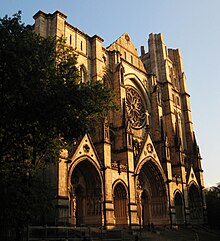Cathedral of St. John the Divine
| Cathedral of Saint John the Divine | |
|---|---|

The Western facade, including the Rose Window
|
|
| Basic information | |
| Location | Manhattan, New York City |
| Geographic coordinates | 40°48′13″N 73°57′42″W / 40.8036°N 73.9617°WCoordinates: 40°48′13″N 73°57′42″W / 40.8036°N 73.9617°W |
| Affiliation | Episcopal Church in the United States of America |
| District | Episcopal Diocese of New York |
| State | New York |
| Status | Active |
| Website | StJohnDivine |
| Architectural description | |
| Architect(s) | Christopher Grant LaFarge and George Lewis Heins; Ralph Adams Cram |
| Architectural type | Cathedral |
| Architectural style | Romanesque Revival and Gothic Revival |
| Groundbreaking | December 27, 1892 |
| Materials | Stone, Granite, Limestone |
The Cathedral of St. John the Divine, officially the Cathedral Church of Saint John: The Great Divine in the City and Diocese of New York, is the cathedral of the Episcopal Diocese of New York. It is located in New York City on Amsterdam Avenue between West 110th Street and 113th Street in Manhattan's Morningside Heights neighborhood.
Designed in 1888 and begun in 1892, the cathedral has undergone radical stylistic changes and the interruption of the two World Wars. Originally designed in the Byzantine Revival-Romanesque Revival styles, the plan was changed after 1909 to a Gothic Revival design. After a large fire on December 18, 2001, it was closed for repairs and reopened in November 2008. It remains unfinished, with construction and restoration a continuing process. As a result, it is often nicknamed St. John the Unfinished.
There is a dispute about whether this cathedral or Liverpool Cathedral is the world's largest Anglican cathedral and church. It is also the fourth largest Christian church in the world. The interior covers 121,000 sq ft (11,200 m2), spanning a length of 601 ft (183.2 meters) and height 232 ft (70.7 meters). The interior height of the nave is 124 feet (37.8 meters).
The cathedral houses one of the nation's premier textile conservation laboratories to conserve the cathedral's textiles, including the Barberini tapestries to cartoons by Raphael. The laboratory also conserves tapestries, needlepoint, upholstery, costumes, and other textiles for its clients.
In 1887 Bishop Henry Codman Potter of the Episcopal Diocese of New York called for a cathedral to rival the Catholic St. Patrick's Cathedral in Manhattan. An 11.5-acre (4.7 ha) property, on which the Leake and Watts Orphan Asylum had stood, was purchased by deed for the cathedral in 1891. After an open competition, a design by the New York firm of George Lewis Heins and Christopher Grant LaFarge in a Byzantine-Romanesque style was accepted the next year.
...
Wikipedia
